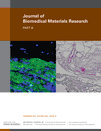Synthesis of biologically active and photostable rigid poly(vinyl chloride)†
How to cite this article: Rabie ST, El-Saidi MMT, Mohamed NR. 2012. Synthesis of biologically active and photostable rigid poly(vinyl chloride). J Biomed Mater Res Part A 2012:100A:3503–3510.
Abstract
N,N-Dimethyl-N′-(6-oxo-2-thioxo-1H-pyrimidine-4-yl)formamidine has been synthesized and introduced as a substituent in poly(vinyl chloride) (PVC) chains via a chemical reaction. Both the dimethyl derivative and the modified PVC have been characterized via spectroscopic analyses and their biological activities have been evaluated. Both IR and 1H NMR spectral data confirm the incorporation of the newly prepared bioactive dimethyl pyrimidine derivative in the polymeric chains. The dimethyl pyrimidine derivative has exhibited good antibacterial and antifungal activities. The modified PVC shows higher antibacterial effects than that of the blank one. Photostabilizing efficiency of the modified PVC is determined by measuring the changes that occurred in the molecular weights of modified PVC samples after UV irradiation using the gel permeation chromatography technique. The extent of discoloration of the photodegraded modified PVC samples has also been measured. The results have been compared with that of the blank PVC and that of the PVC stabilized with phenyl salicylate as a reference UV absorber. The lower decrease in the values of weight average molecular weight, Mw, at the first stages of UV irradiation and the absence of crosslinking at the latter stages of irradiation confirms the photostability of the modified PVC. The extent of discoloration of the modified sample is also decreased when compared with the blank and stabilized PVC samples. © 2012 Wiley Periodicals, Inc. J Biomed Mater Res Part A: 100A:3503–3510, 2012.




